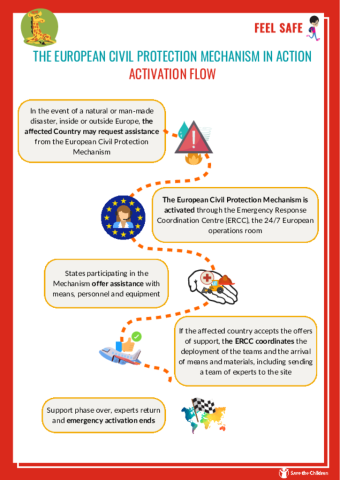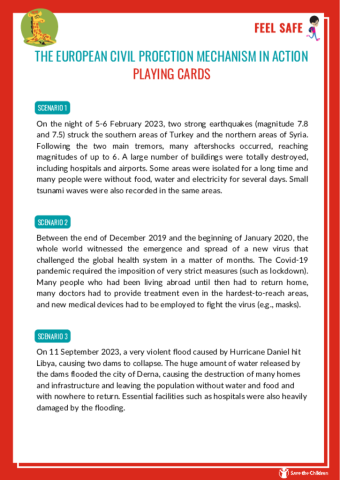The European Civil Protection Mechanism in action
Objectives:
- Get to know the European Civil Protection Mechanism
- Get to know how the European Civil Protection Mechanism works
STEP BY STEP
BEFORE STARTING
A State is not always able to cope with the consequences of an emergency event occurring within its territory. For example, the Covid-19 pandemic that affected all the countries of the world put a strain on the health and civil protection system and required the collaboration of various countries to manage and overcome the emergency. At this point, the teacher asks the class the following question: how do the civil protection systems of different states manage to work together to manage and overcome emergencies? Are there conditions that can favour or limit collaboration between different states?
After a brief discussion, the teacher reveals to the class that a civil protection system based on the cooperation of EU member states (and 10 other non-member states) exists and it is called the “European Civil Protection Mechanism”. The Mechanism aims to improve prevention, cooperation and response to disasters affecting any state in the world.
THE EUROPEAN CIVIL PROTECTION MECHANISM
In 2001, the European Commission established the European Civil Protection Set of competences and activities aimed at protecting life, physical integrity, property, settlements, animals and the environment from damage or the danger of damage resulting from calamitous events of both natural and man-made origin. Mechanism. The Mechanism has a dual purpose: on the one hand, it allows for a coordinated response to emergencies affecting a state anywhere in the world, avoiding duplication of resources and means used to bring assistance to the affected state. On the other, it promotes a culture of prevention with the aim of reducing the effects of disasters and making territories and the people who inhabit them more resilient.
HOW IS THE MECHANISM ACTIVATED?
When a Member State cannot cope with a national emergency, it can request assistance by activating the Emergency Response Coordination Centre (ERCC) which monitors events worldwide 24/7. Upon receiving a request, the ERCC alerts all the components of the Mechanism through a computer system called CECIS (Common Emergency Communication and Information System). Through the ERCC, communication between the Mechanism and the Member States remains active throughout the emergency. The ERCC coordinates the mobilisation of intervention teams, experts and civil protection Set of competences and activities aimed at protecting life, physical integrity, property, settlements, animals and the environment from damage or the danger of damage resulting from calamitous events of both natural and man-made origin. modules to the affected state and ensures the rapid deployment of emergency support through a direct link with national civil protection authorities. The Mechanism's resources are contained in a pool created by the Member States on a voluntary basis, ready to be deployed at any time both within and outside the European Union. Since 2001, the Mechanism has been activated more than 700 times. To learn more about how the Mechanism is activated, the teacher can show the class this video or share the information sheet "The European civil protection mechanism in action - Activation flow" (below).
EU Civil Protection Mechanism explained
THE MECHANISM IN ACTION
The teacher divides the class into groups. Each group is assigned a scenario describing an emergency situation that requires activation of the Mechanism and a set of cards representing some of the resources in the Mechanism’s pool that can be activated to respond to the emergency. Each group will have to “activate the Mechanism” and find the resources they consider useful to send to the state in need of help. The teacher can use the "scenarios proposed in the attachment "The European civil protection Set of competences and activities aimed at protecting life, physical integrity, property, settlements, animals and the environment from damage or the danger of damage resulting from calamitous events of both natural and man-made origin. mechanism in action - Playing cards" (below) or create their own scenarios and cards (for the creation of the cards the teacher can use the information in the European Commission portal (link).
Each group will have 20 minutes to read their scenario and decide which pool resources to activate to handle the emergency. At the end of the allotted time, each group will share their choices with the class.
CONCLUDING THOUGHTS
Four essential elements characterise the European Civil Protection Mechanism: collaboration, prevention, response and proactive coping with emergencies. Each of us can put these three elements into play and thus be part of Civil Protection. What can you do to bring these elements into play in your daily lives as individuals and as class members?


Add new comment